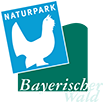From trees to glass
Depending on the agricultural usage in the Nature Park, different amounts of forest can be found varying from region to region. Whereas the amount of forest is very low in the Dungau, it is at its highest in the Inner Bavarian Forest. Altogether, however, around half of the area in the Nature Park is covered by trees.
Not easy to imagine today, large sledges have been used in former times to transport the wood in winter into the settlements or to specially prepared rivers. Along these large systems of prepared rivers, it was possible to take the logs from the Inner Bavarian Forest via the "Great Regen" and the Ilz to the large population centers like Regensburg and Passau. This action was called "triften". It was only with the building of the forest railway that the water systems lost their importance. In the 50ies forestry roads were built and lorries were used for the transport of the logs.
Wood was not only important as a building material but also an important resource in glass manufacturing. The glassworks which needed the wood to heat the ovens and to provide potash were the main users of the forests for a long time. It took three times as much wood to make potash, a material used to lower the melting point of quartz sand, than it did to heat the ovens.
Wood usage by the state became more and more important after the introduction of the systematic forest-management at the end of the 18th century.
The original forests have undergone a series of changes over the centuries. Today spruce is the predominant tree in the whole of the Nature Park. Often this is the result of human planting rather than natural succession. These spruce forests are especially prone to air pollution, insect attacks and storm damage. It is questionable if they can continue to fulfil the different forest functions in the long run, such as usage, protection and recreation. Therefore it is very important to manage the woodlands in a way close to the laws of nature, to ensure that the ever-growing demands on the forests, such as stability, production, ecology and economy are still fulfilled.


